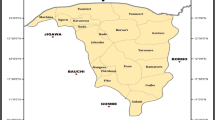Abstract
Diarrheal disease continues to be a global health problem, particularly among young ones in developing nations. Amongst several viral and non-viral agents associated with diarrhea, group A rotavirus has been recognized as the major etiological agent of childhood gastroenteritis in human infants as well as several animal species throughout the world. During this study, a total of 181 diarrheic stool samples collected from children, piglets, buffalo and cow calves of Madhya Pradesh, central India were analyzed by electrophoretic mobilities of the 11 segments of dsRNA by polyacrylamide gel electrophoresis (PAGE). This technique revealed prevalence of rotavirus among different species (human-26.09%, pig-25.71%, buffalo-23.61% and cattle-21.43%). Prevalence of existence of circulating 8 different electropherotypes of group A rotaviruses indicated high genomic diversity among rotaviruses in this geographical region. Majority of the electropherotypes from humans and animals were of long pattern (75%) than short electropherotypes (9.09%). Same electropherotype was found to exist either only in a single species or in more than one species implicating the possibility of cross species transmission of the rotavirus strains. As it was found that certain animal rotavirus strains had electropherotypic similarities to some human strains, speculation increased about whether animals play a role as a source of rotavirus infection in humans or vice-versa. There is a need for further detailed study on the molecular characterization of rotaviruses which would have important implication in vaccine evaluation program.
Similar content being viewed by others
References
Reinhardt G, Riedemann T, Polettee M, Aguilar M and Niedda M (1986) Diarrhea neonatal. Infection of rotavirus in bovines and porcine. Arch Med Vet 18:23–27
Estes MK and Cohen J (1989) Rotavirus gene structure and function. Microbiol Rev 53: 410–449
Estes MK, Graham DY and Dimitrov DH (1984) The molecular epidemiology of rotavirus gastroenteritis. Prog Med Virol 29:1–22
Tam JS, Kum WW, Lam B, Yeng CY and Ng MH (1986) Molecular epidemiology of human rotavirus infection in Hong Kong. J Clin Microbiol 23:660–664
Singh V, Broor S, Mehta S and Mehta SK (1990) Molecular epidemiology of human rotavirus infections in Chandigarh (India). Indian J Med Res 91:9–14
Blumer C, Roche P, Kirkwood C, Bishop R and Barnes G (2003) Surveillance of viral pathogens in Australia. Commun Dis Intellig 27:496–503
Albert MJ, Soenarto Y and Bishop RF (1982) Epidemiology of rotavirus diarrhea in Yogyakarta, Indonesia, as revealed by electrophoresis of genome RNA. J Clin Microbiol 16:731–733
Martella V, Pratelli A, Greco G, Tempesta M, Ferrari M, Losio MN and Buonavoglia C (2001) Genomic characterization of porcine rotaviruses in Italy. Clin Diagn Lab Immunol 8:129–132
Santos N, Lima RCC, Nozawa CM, Linhares RE and Gouvea V (1999) Detection of porcine rotavirus type G9 and of a mixture of types G1 and G5 associated with Wa-like VP4 specifi city: Evidence for natural human-porcine genetic reassortment. J Clin Microbiol 37:2734–2736
Coluchi N, Munford V, Manzur J, Vazquez C, Escobar M, Weber E, Marmol P and Racz ML (2002) Detection, subgroup specificity, and genotype diversity of rotavirus strains in children with acute diarrhea in Paraguay. J Clin Microbiol 40:1709–1714
Varghese V, Das S, Singh NB, Kojima K, Bhattacharya SK, Krishnan T, Kobayashi N and Naik TN (2004) Molecular characterization of a human rotavirus reveals porcine characteristics in most of the genes including VP6 and NSP4. Arch Virol 146:155–172
Herring AJ, Inglis NF, Ojeh CK, Snodgrass DR and Menzies JD (1982) Rapid diagnosis of rotavirus infection by direct detection of viral nucleic acid in silver-stained polyacrylamide gels. J Clin Microbiol 16:473–477
Sevensson L, Uhnoo I, Garndien M and Wadell G (1986) Molecular epidemiology of rotavirus infection in Upsala, Sweden, 1981: Disappearance of a predominated electropherotype. J Clin Microbiol 18:101–111
Ojeh CK, Snodgrass DR and Herring AJ (1984) Evidence for serotypic variation among bovine rotaviruses. Arch Virol 79:161–171
Fijtman NL, Barandeguy ME, Cornaglia EM., Schudel AA (1987) Variations and persistency of electropherotypes of bovine rotavirus field isolates. Arch Virol 96:275–281
Suzuki Y, Sanekata T, Sato M, Tajima K, Matsuda Y and Nakagomi O (1993) Relative frequencies of G (VP7) and P (VP4) serotypes determined by polymerase chain reaction assays among Japanese bovine rotaviruses isolated in cell culture. J Clin Microbiol 31:3046–3049
Ghosh SK and Naik TN (1989) Detection of a large number of subgroup 1 human rotaviruses with a long RNA electropherotype. Arch Virol 105:119–127
Sukumaran M, Gowda K, Maiya PP, Srinivas TP, Kumar MS, Aijaz S, Reddy RR, Padilla L, Greenberg and Rao CD (1992) Exclusive asymptomatic neonatal infections by human rotavirus strains having subgroup I specificity and “long” RNA electropherotype. Arch Virol 126:239–251
Saravanan P, Ananthan S and Ananthasubramanian M (2004) Rotavirus infection among infants and young children in Chennai, South India. Indian J Med Microbiol 22:212–221
Brown DWG, Mathan MM, Mathew M, Martin R, Beards GM and Mathan VI (1988) Rotavirus epidemiology in Vellore, South India: Group, subgroup, serotype, and electropherotype. J Clin Microbiol 26:2410–2414
Broor S, Husain M, Chatterjee B, Chakraborty A and Seth P (1993) Temporal variation in the distribution of rotavirus electropherotypes in Delhi, India. J Diarr Dis Res 11:14–18
Sharma R (2004) Isolation and molecular characterization of rotavirus associated with diarrhea in bovine calves. MVSc Thesis, JNKVV, Jabalpur
Pongsuwanne Y, Taniguchi K, Choonthanom M, Chiwakul M, Susansook T, Saguanwongse S, Jayavasu C and Urasawa S (1989) Subgroup and serotype distributions of human, bovine, and porcine rotavirus in Thailand. J Clin Microbiol 27:1956–1960
Theil KW and McCloskey CM (1989) Molecular epidemiology and subgroup determination of bovine group A rotaviruses associated with diarrhea in dairy and beef calves. J Clin Microbiol 27:126–131
Author information
Authors and Affiliations
Corresponding author
Rights and permissions
About this article
Cite this article
Kusumakar, A.L., Savita, Malik, Y.S. et al. Genomic diversity among group A rotaviruses from diarrheic children, piglets, buffalo and cow calves of Madhya Pradesh. Indian J Microbiol 50, 83–88 (2010). https://doi.org/10.1007/s12088-010-0016-y
Received:
Accepted:
Published:
Issue Date:
DOI: https://doi.org/10.1007/s12088-010-0016-y




